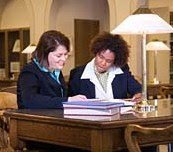
You probably don't give much thought to the mail--in general--or the mail that comes to your house. If you've come to the U.S. from a country where there is no structured mail system, though, this daily delivery can seem like both a miracle and a baffling mystery.
Imagine opening the mailbox and looking through the contents, not knowing what is important, what is advertising, and what is personal correspondence. You wonder: Why are these things coming at all? Also consider feeling so overwhelmed by the not knowing that you simply stop picking up the mail at all.

For our students who are not literate or who haven't yet learned to read using a different alphabet, sorting through the mail can be a frustrating challenge. Your student thinks,
Maybe it's all important. Maybe none of it is important. It might not even be for me. What do I do with it now that I have it?One of the first things you can do is teach your student to recognize her (or his) name in print. Look at it typed, handwritten, and printed in different typefaces. Try to get to a point where she can pick out her own name when there is other text on the same page (or envelope).
Next, consider sending mail to your student. Why not start with a Valentine? You can buy one or create one by hand or on your computer. An easy-to-read message using simple language will be most effective. Address the card by hand and print the student's name and address clearly. Think about how a kindergarten teacher would address a card for a student. Let there be no ambiguity!
This can be the start of a good culture lesson. When and why do we send cards? To whom do we send them? Where do you sign it? What is the proper way to sign? My mother recently sent me a box filled with papers, projects, and cards from when I was in the earliest years of elementary school. Birthday cards and Mother's Day cards bear the carefully printed endearment, "From, your daughter Sharon McCreary." At least there was no doubt about the origin of the warm wishes.
Think of a lesson about buying stamps, properly addressing a piece of mail and using a return address, or dealing with misdirected mail. I was surprised recently when I found out how many
Americans don't know what you're supposed to do with misdirected/mis-delivered mail that arrives at your house (hint: You are
not supposed to throw it in the trash!).
Are you going on vacation? Consider sending a picture post card to your student. Don't forget about your student's birthday! You can also send thank-you cards, "thinking of you," cards, notes or cards that celebrate a job well done, a short note if you miss a lesson, a photograph you took, or holiday cards.

In our busy, modern lives, mail can sometimes feel like just one more thing to deal with, but I'll bet that when you shuffle through the bills and junk mail, your curiosity is piqued by a hand-addressed piece of personal mail. It will likely be the first thing you open because it's special just by the nature of being part of a personal connection. This program is all about personal connections.
So, why not start now? Valentine's Day is less than a week away. Whether you buy a card or make one, this is great time to start incorporating the mail into your teaching--and to let your student know you think of her often.













